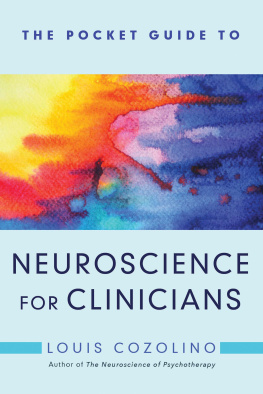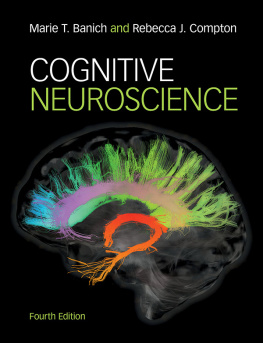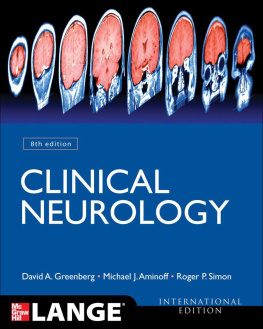Clinical Neuroscience
An Illustrated Colour Text
Paul Johns, BSc BM MSc FRCPath
Consultant Neuropathologist and Senior Lecturer in Neuroanatomy, St George's Healthcare NHS Trust and St George's University of London, London, UK

EDINBURGH LONDON NEW YORK OXFORD PHILADELPHIA ST LOUIS SYDNEY TORONTO 2014
Table of Contents
Copyright

2014 Elsevier Ltd. All rights reserved.
No part of this publication may be reproduced or transmitted in any form or by any means, electronic or mechanical, including photocopying, recording, or any information storage and retrieval system, without permission in writing from the publisher. Details on how to seek permission, further information about the Publisher's permissions policies and our arrangements with organizations such as the Copyright Clearance Center and the Copyright Licensing Agency, can be found at our website: www.elsevier.com/permissions.
This book and the individual contributions contained in it are protected under copyright by the Publisher (other than as may be noted herein).
ISBN 978-0-443-10321-6
ebook ISBN 978-1-4557-4212-7
British Library Cataloguing in Publication Data
A catalogue record for this book is available from the British Library
Library of Congress Cataloging in Publication Data
A catalog record for this book is available from the Library of Congress
Notices
Knowledge and best practice in this field are constantly changing. As new research and experience broaden our understanding, changes in research methods, professional practices, or medical treatment may become necessary.
Practitioners and researchers must always rely on their own experience and knowledge in evaluating and using any information, methods, compounds, or experiments described herein. In using such information or methods they should be mindful of their own safety and the safety of others, including parties for whom they have a professional responsibility.
With respect to any drug or pharmaceutical products identified, readers are advised to check the most current information provided (i) on procedures featured or (ii) by the manufacturer of each product to be administered, to verify the recommended dose or formula, the method and duration of administration, and contraindications. It is the responsibility of practitioners, relying on their own experience and knowledge of their patients, to make diagnoses, to determine dosages and the best treatment for each individual patient, and to take all appropriate safety precautions.
To the fullest extent of the law, neither the Publisher nor the authors, contributors, or editors, assume any liability for any injury and/or damage to persons or property as a matter of products liability, negligence or otherwise, or from any use or operation of any methods, products, instructions, or ideas contained in the material herein.



Printed in China
Dedication
For Iris,
Born on the 5th of December, 2013
Preface
This new addition to the Illustrated Colour Text (ICT) series provides a short, readable introduction to basic and clinical neuroscience. It is intended to contain all you need to know to get a good understanding of the nervous system and its most important disorders. There are two main aims:

Explain the core principles of cellular and molecular neuroscience, emphasising aspects that are important for understanding common brain diseases

Provide an integrated, up-to-date description of the most important neurological disorders (such as stroke, epilepsy and dementia) and their scientific basis.
This text should be an ideal companion to the very popular Neuroanatomy ICT by Crossman and Neary and has been written in the same chapter-based format. Although the book is not divided into sections, the second half is more clinically-orientated than the first.
The earlier chapters introduce a number of core neuroscience topics, including the development, anatomy and cellular constituents of the nervous system. Some fundamental (and potentially confusing) concepts are explained, including the electrical properties of neurons and the principles of synaptic transmission. Before moving on to discuss specific neurological conditions in detail, there is an introductory chapter on the cellular mechanisms of neurological disease, which provides an overview of basic pathological processes (such as inflammation, gliosis, cell death and neurodegeneration).
The second half of the book focuses on the most common and important neurological disorders, with separate chapters on head injury, stroke, epilepsy, dementia, Parkinson's disease and multiple sclerosis. These provide a comprehensive and integrated introduction to each main disease, together with a number of associated and related conditions. Each chapter begins with the key clinical features (e.g., symptoms, signs and main imaging findings) before describing how each disorder is diagnosed and treated. Sections on aetiology and pathogenesis draw on relevant aspects of anatomy, pathology, physiology and pharmacology. In addition, numerous clinical boxes (with a blue stethoscope icon) are scattered throughout the text, highlighting a wide range of neurological diseases, investigations and treatments.
Neuroscience is a challenging subject that is easier (and more interesting) to learn when it is understood rather than memorised; for this reason, emphasis has been placed on comprehension rather than rote learning. For instance, when new terms are introduced the word origins are usually given in brackets (at least when they seem to make sense!) and some of the more difficult-to-pronounce words have been spelled out phonetically. To summarise and reinforce the most important information (and to facilitate exam preparation) succinct key points boxes are provided throughout.
The text has been prepared with the needs of medical students in mind and should be suitable for the majority of undergraduate medical courses; in addition, the integrated style should fit well with case-based and problem-based curricula. The content should be suitable not only for the earlier, more theoretical years of medical school (when exam preparation and revision are often foremost in the mind) but also in the later, more clinically-orientated years when the priority shifts towards survival during ward rounds and outpatient clinics! It should also be useful as an update and refresher for junior doctors embarking on potentially-daunting neuro rotations or for those entering specialist training in neurology-related disciplines.
Although it will be of particular interest to medical students and junior doctors, the book is suitable for anyone interested in the nervous system and its disorders, including undergraduate and postgraduate students in neuroscience, psychology and the biomedical sciences. The content is also relevant to a wide range of healthcare professions allied to medicine which require a basic knowledge of the nervous system and its disorders. To help make it more accessible to non-medical readers, a brief appendix of anatomical terminology has been included.














 Explain the core principles of cellular and molecular neuroscience, emphasising aspects that are important for understanding common brain diseases
Explain the core principles of cellular and molecular neuroscience, emphasising aspects that are important for understanding common brain diseases